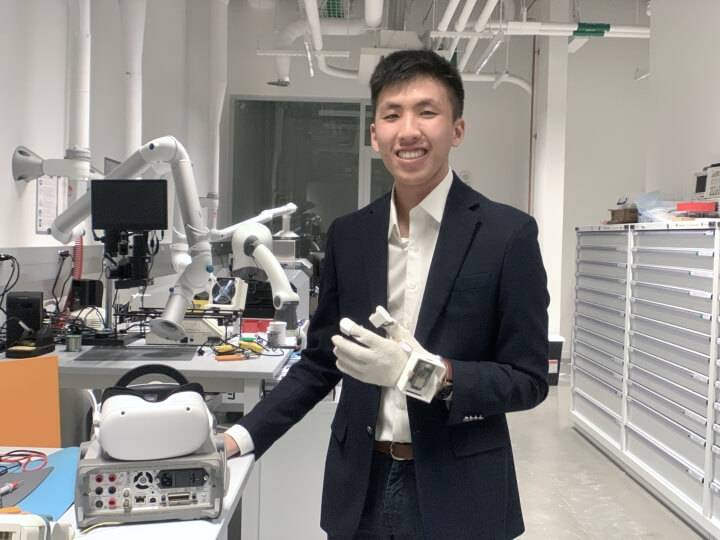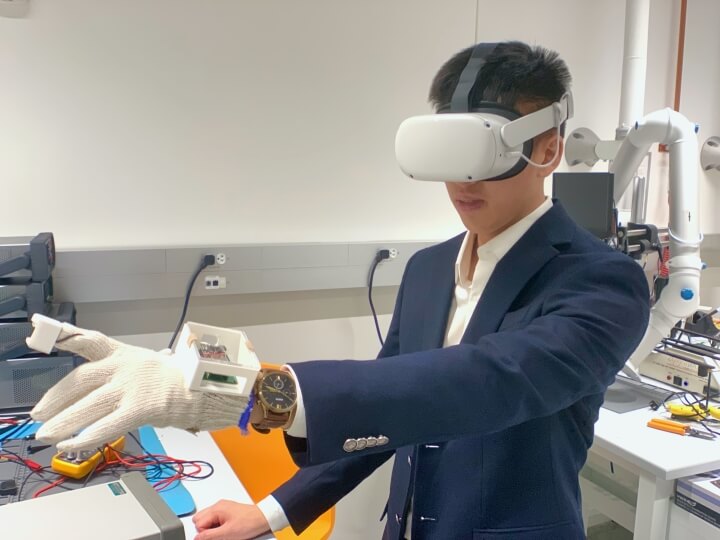For a senior capstone project, Aaron Chin programmed a glove to provide haptic feedback in a virtual environment. (Matt Goisman/SEAS)
Engineering Design Projects (ES 100), the capstone course at the Harvard John A. Paulson School of Engineering and Applied Sciences (SEAS), challenges seniors to engineer a creative solution to a real-world problem.
Designing an Actuator Optimized for Haptic Force Feedback in VR
Aaron Chin, S.B. ‘23, Electrical Engineering
Advisor: Gage Hills, Cara Nunez
Please give a brief summary of your project.
With virtual reality's (VR) need for haptic immersion so that users can naturally interact with virtual environments, this project aims to improve current tactile force feedback technology. The intended application is to improve virtual reality’s user interface and better connect friends and coworkers through virtual interactions. I designed and optimized an electromagnetic actuator to provide tactile sensations to the palm, integrated several of these actuators into a string-knit glove to provide haptic feedback to the thumb, index finger and palm, and demonstrated the system in a 3D virtual environment.
How did you come up with this idea for your final project?
I went to a startup fair, and a company there was demonstrating their own VR haptic glove.It was a cool experience interacting with different virtual objects and envisioning how this technology could improve virtual reality's ability to connect and educate its users. However, I also remember as I was wearing the glove how it was uncomfortable to wear, especially for everyday use.
Is there a real-world challenge that this project addresses?
With virtual reality's ability to create real-world interactions, it has the ability to better connect people than how social media and our phones can today. However, virtual reality's user interface is often unintuitive, making it difficult for the average consumer to use for everyday applications such as socializing with a friend or attending a meeting. Haptic force feedback gloves offer a promising solution by providing further immersion into virtual environments through simulating haptic sensations to the hands, allowing users to naturally feel and interact with virtual objects. Existing haptic force feedback gloves are often difficult to wear, expensive and only provide haptic sensations to the fingertips. I aimed to design a haptic glove that is easier to wear, while still providing full-hand haptic sensations.
What was the timeline of your project?
Before the school year began, I had brainstormed potential force mechanisms that would drive my haptic sensations, and performed a proof of concept to validate my chosen design. During the fall semester, I experimented with my design to determine what would yield the maximum force output. The spring semester was when I mainly built an initial and final prototype for the designed actuators. I designed a finger cast for the thumb and index fingertip, then slowly integrated the finger casts with the rest of the circuitry, actuators and electronics in the glove. I also started working with the Harvard AR/VR Club to develop a virtual environment to demonstrate the designed glove's haptic sensations in response to everyday object interactions.
Aaron Chin's senior capstone project is a glove that provides haptic feedback when interacting with objects in virtual reality. (Matt Goisman/SEAS)
What part of the project proved the most challenging?
What makes wearable technology an interesting problem, especially when intended to reach a broad audience, is that it requires designing with a high level of detail because it has to be easy and safe for anyone to use. I was challenged the most in the fabrication of my glove because it was difficult in accounting for unexpected design problems that occurred. Figuring out how all the wires are going to be insulated and connected through the glove, how this glove design would be able to accommodate for all hand sizes, and how to make the glove resilient to potential risks posed through regular household use were all questions that I had to consider in my design.
What part of the project did you enjoy the most?
I really enjoyed being able to complete this project with the support of the Harvard SEAS community. I am so grateful for my advisors who walked with me throughout this entire thesis process. It was so encouraging to be able to talk to the Active Learning Lab staff and discuss fabrication techniques and circuit design with them to get feedback on design ideas. The other ES100 students were also super supportive, and it was such a joy working alongside brilliant engineers for long hours in the SEC.
What did you learn, or skills did you gain, through this project?
The multidisciplinary nature of this project was a rewarding experience where I was able to learn not only more about mechanical, electrical and software engineering, but also how to connect these disciplines together to create a working wearable device. Through this project, I built a custom printed control board for the first time, and also learned how to sew, which was crucial in being able to integrate all my parts into the glove. Working with microcontrollers and developing a Unity environment gave me a more in-depth look into the software development side of virtual reality technology. Most importantly, I learned how to fail through this project and to not be afraid to do so as I continued to learn, iterate and develop my design.
Press Contact
Matt Goisman | mgoisman@g.harvard.edu

